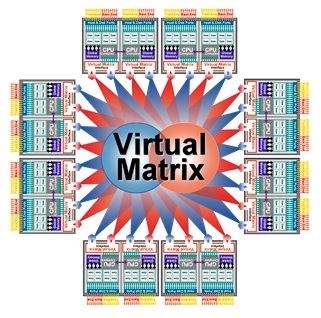This article is more than 1 year old
Arrays take on servers in storage smackdown
Location, location, location: Where's a storage box's soul?
Storage array vendor conundrum
The mainstream external storage array vendors are facing two, not one, strategic challenges to their long-term hegemony. The nearer term one is the introduction of networked flash-only arrays from companies like Huawei, Nimbus, Pure Storage and others, which threaten to cream off their profitable fast array business based on 15,000rpm Fibre Channel disk drives. All primary data storage could migrate to flash-only arrays, leaving the EMC, Dell, HDS, HP, IBM and NetApp-style vendors to store the bulk data crumbs, the low-access rate, lower profit, online data repositories.

EMC VMAX array Virtual Matrix
The second threat though is the more important one because, after all, a networked external flash storage array is still a networked external storage array. Co-locating servers and storage with no traditional storage networking protocol connecting them is different. If servers absorb external storage, as is the Oracle Exadata plan, or external storage absorbs servers, as is the import of Dell and EMC's plans, then networked external storage is no longer needed: we have the NoSAN server.
There's a distinction to be made between converged systems with co-located servers and storage using storage networking protocols and converged systems that do not, the NoSAN servers.
A VCE Vblock, an HP VS3 and a NetApp Flexpod set-up all use networked external storage. An app-running VMAX has no storage networking protocol needed to link servers (app-executing VMAX engines) and storage (storage controller app-executing VMAX engines) as they all hook into the VMAX internal fabric. This is fundamentally an entirely different beast. For a start the server-storage link is proprietary and not open. You wouldn't be able to substitute a NetApp, HP or IBM array for the VMAX storage part of VMAX app-executing system. It would be like trying to put a BMW engine in a Mercedes car. Good luck to you and don't expect any sympathy for the grief heading your way.
Criticise Fibre Channel, FCoE and iSCSI all you like but they are open systems allowing you to switch suppliers of servers and storage either side of the storage networking link.
FCoE becomes irrelevant
Discussions about whether to move to Fibre Channel over Ethernet (FCoE) from Fibre Channel will be rendered irrelevant by co-located servers and storage communicating across some kind of I/O backplane or mesh network, or servers and storage talking across PCIe. FCoE is a transition from one instantiation of a legacy storage-server connection protocol to another.
The future may be not to have a storage networking protocol at all. Data will ship between server memory and flash to co-located array storage across PCIe buss links or an array's internal fabric.
What this means for stand-alone storage array products is that a razor thin end of a wedge is appearing in the door through which they sell their arrays. This wedge can be expected to fatten. If it does, then the external array business will be impacted. It may be that data growth will be such that array sales increase while NoSAN server storage sales grow as well. But there is a long-term threat here, looking at a five-year or 10-year timescale, in which the external array business declines.
Its only hope of rescue will be through the provision of external array links that match the latency and bandwidth of third-gen PCIe, or internal array fabrics such as is found inside VMAX.
A strategic battle has been joined and the existence of the external storage array business is being questioned. Yes, it's a razor thin wedge that has been slipped into the external array door, but wedges do what wedges do: they become thicker. If Dell and EMC pull their NoSAN server ideas off, then a world of hurt awaits external array vendors that have no effective response. ®
